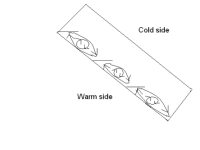There are three principal methods of heat loss through a window. These are radiation, conduction and convection. Radiation losses may be greatly reduced by means of and IR blocking (low E) coating applied to the warmer side of the window. Conduction losses can decrease by the choice of filling gas between the panes (we assume 2 or more panes) or by increasing the spacing between the panes. Unfortunately, increasing the spacing between panes to more than about .5-.75 inches results in increased bulk convection that more than compensates for any decrease in conduction loss. figure 1 which shows the effect of having widely spaced panes.
Our proposed improvement involves using 2 panes of glass with appropriate IR (low E) coatings on one or both sides and a large air (or argon or krypton) gap. We then need to find a solution to the large bulk convection that normally results from a large gap between panes. The solution is somewhat different for a vertical window and a non-vertical window or skylight. They are described, separately below.
What we propose are fins that are made of a low thermal conductivity, such as Lexan, and that have a height to spacing ratio of about 1 to 10. This will cause the flow to be like that in Figure 2 with the warmed gas inside the glass slowed by the fins and recirculating behind them rather than flowing to the cool pane and dropping down the cool side. Here the cool side flow is also slowed by the fins and has some recirculation. Note that the flow isn’t precisely the same on the warm and cold side, nor is it the same on each fin on a side. The flow is also, obviously upward on the warm side. It is, however, similar and the recirculating areas near the fins reduce the bulk flow around the window while the gas just spins locally.
The heat transfer in the recirculation regions is quite low because the gas tends to reach a near equilibrium temperature with the air external to the adjacent pane and recirculate stably.
A skylight or other non-vertical window cannot use exactly the same systems of fins as figure 2 because the direction of gravity affects the flows. For a skylight, if one wants to be energy efficient in summer the top should be insulated and covered both the avoid heat gain generally and high summer sun that will directly heat the building. Figure 3 shows a way that a skylight can be made lower loss in the winter. The fins on the warm side are angled in order to better force recirculation. They are, as in the vertical case, perpendicular to the direction of gravity. Here it is clearly advantageous to make the fins out of a transparent material. The fins spacing to width is about six.
Voting
-
ABOUT THE ENTRANT
- Name:Alan Kaplan
- Type of entry:individual
- Number of times previously entering contest:2
- Alan's favorite design and analysis tools:Paper, Pencil, Brain
- For managing CAD data Alan's company uses:Orcad
- Alan's hobbies and activities:Sailing, Photography
- Alan belongs to these online communities:None
- Alan is inspired by:I always try for both better and simpler solutions than those in common use.
- Patent status:none








